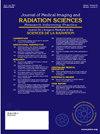用于制定放射治疗MRI工作流程的志愿者成像的偶然发现
IF 1.3
Q3 RADIOLOGY, NUCLEAR MEDICINE & MEDICAL IMAGING
Journal of Medical Imaging and Radiation Sciences
Pub Date : 2025-02-20
DOI:10.1016/j.jmir.2025.101863
引用次数: 0
摘要
简介/背景健康志愿者成像对于优化序列用于治疗计划途径是不可或缺的,以确保它们符合目的。虽然最初的成像可能不是最佳质量,但仍有可能识别异常。方法纳入所有健康志愿者,这些志愿者被招募到本机构旨在优化MRI序列用于放射治疗的批准研究中。参与者在MR Sim (Philips Ingenia, Best,荷兰)或MR Linac系统(Unity, Elekta,瑞典)或两者上进行成像,每个成像时间点分别进行分析。结果145名参与者接受了258次影像学检查。在31名(21.3%)参与者中发现了偶然发现。96名参与者为女性,中位年龄29岁(22-59岁)。影像学检查由四名放射科医生中的一名进行审查,并根据临床意义对结果进行分类。在11例中,建议继续转诊:3例被定义为潜在严重。7个国家有书面咨询,告知参与者报告的调查结果和采取的行动。阳性预测值45%,阴性预测值100%。两种成像系统的发现数量无差异(p = 0.15)。偶然发现的比率与文献比较有利。这一比率不容忽视,放疗服务机构应意识到需要制定和审核适当管理检查结果的程序。结论mri扫描仪不是放疗机构的常规管理。在大约4%的健康志愿者中发现了潜在的重大发现,并且围绕处理发现的程序可能是放射治疗服务的新方法。本文章由计算机程序翻译,如有差异,请以英文原文为准。
Incidental findings in volunteer imaging used to develop radiotherapy MRI workflows
Introduction/Background
Healthy volunteer imaging is integral to optimising sequences for use in a treatment planning pathway to ensure they are fit for purpose. Although initial imaging may not be optimal quality, it may still be possible to identify abnormalities.
Methods
All healthy volunteer participants recruited to approved studies aimed at optimising MRI sequences for use in radiotherapy at our institution were included. Participants were imaged on either an MR Sim (Philips Ingenia, Best, Netherlands) or MR Linac system (Unity, Elekta, Sweden), or both and each imaging time point was analysed separately.
Results
145 participants underwent 258 imaging sessions. Incidental findings were identified in 31 (21.3 %) participants. 96 participants were female and median age 29 years (range 22–59). Imaging was reviewed by one of four radiologists and findings categorised in terms of clinical significance. In eleven cases, onward referral was recommended: Three defined as potentially serious. Seven had a documented consultation informing participants of report findings, and actions taken. Positive predictive value was 45 % and negative predictive value 100 %. There was no difference in number of findings between imaging system (p = 0.15).
Discussion
Rate of incidental findings compares favourably with the literature. This rate cannot be ignored, and radiotherapy services should be aware of the need to develop, and audit, procedures that appropriately manage findings.
Conclusion
MRI scanners are not routinely managed by radiotherapy services. Potentially significant findings are seen in around 4 % of healthy volunteers and the procedures around managing findings may be new to radiotherapy services.
求助全文
通过发布文献求助,成功后即可免费获取论文全文。
去求助
来源期刊

Journal of Medical Imaging and Radiation Sciences
RADIOLOGY, NUCLEAR MEDICINE & MEDICAL IMAGING-
CiteScore
2.30
自引率
11.10%
发文量
231
审稿时长
53 days
期刊介绍:
Journal of Medical Imaging and Radiation Sciences is the official peer-reviewed journal of the Canadian Association of Medical Radiation Technologists. This journal is published four times a year and is circulated to approximately 11,000 medical radiation technologists, libraries and radiology departments throughout Canada, the United States and overseas. The Journal publishes articles on recent research, new technology and techniques, professional practices, technologists viewpoints as well as relevant book reviews.
 求助内容:
求助内容: 应助结果提醒方式:
应助结果提醒方式:


